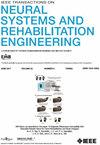耳蜗-前庭联合刺激的可穿戴研究系统
IF 4.8
2区 医学
Q2 ENGINEERING, BIOMEDICAL
IEEE Transactions on Neural Systems and Rehabilitation Engineering
Pub Date : 2025-04-28
DOI:10.1109/TNSRE.2025.3565136
引用次数: 0
摘要
人工耳蜗(CI)是重度到重度听力损失患者的一种成熟的治疗选择,而前庭植入(VI)试验为严重前庭功能受损的患者提供了一个有希望的前景。在许多受试者中,这两种情况也可能同时出现,需要使用耳蜗-前庭植入(CVI)治疗。虽然CVIs的可行性已经得到证实,但目前还没有可穿戴处理器能够为这两个系统提供长时间的特定目标调制刺激。我们推出了第一款可穿戴式音频运动处理器(AMP)系统,旨在与CVI结合使用。我们首先介绍AMP的架构,以及可能的操作模式。然后,我们使用测试台来显示所提出的设备的功能和限制。这种系统的重要性能特征是头部运动和由此产生的前庭刺激脉冲之间的延迟,以及刺激幅度和脉冲速率与程序传递函数(TF)的偏差。该装置在旋转平台上使用振幅和速率调制前庭脉冲响应预定的单轴旋转进行测试,同时为耳蜗电极提供同步听觉刺激。我们能够达到与正常前庭器官的生理反应时间相当的记录潜伏期。实验结果表明,脉冲速率和振幅的测量值与参考值吻合较好。这种音频运动处理器是世界上第一个可穿戴处理器,能够提供联合的,专门调制的耳蜗和前庭刺激。本文章由计算机程序翻译,如有差异,请以英文原文为准。
A Wearable Research System for Combined Cochleo-Vestibular Stimulation
Cochlear implants (CI) are a well-established treatment option for patients with severe to profound hearing loss, while vestibular implant (VI) trials give a promising outlook for patients with severely impaired vestibular function. In a number of subjects these two conditions may also present together, necessitating treatment with a cochleo-vestibular implant (CVI). While the feasibility of CVIs has been demonstrated, no wearable processor has existed to provide target-specific, modulated stimulation for both systems over extended periods. We introduce a first wearable audio-motion processor (AMP) system designed to be used in conjunction with a CVI. We first present the architecture of the AMP, along with the possible modes of operation. We then use a testbench to show the functionality and limits of the presented device. Important performance characteristics of such a system are the latency between head movements and resulting vestibular stimulation pulses, and the deviations of stimulation amplitudes and pulse rates from a programmed transfer function (TF). The device was tested using amplitude- and rate-modulated vestibular pulses in response to predefined single-axis rotations performed on a rotary platform, while providing simultaneous auditory stimulation to cochlear electrodes. We were able to achieve a recorded latency comparable to the physiological response time of normal vestibular organs. The results for the TF showed that the measured values for the pulse rates and the amplitudes followed the reference values very accurately. This audio-motion processor is the world’s first wearable processor capable of delivering combined, specifically modulated cochlear and vestibular stimulation.
求助全文
通过发布文献求助,成功后即可免费获取论文全文。
去求助
来源期刊
CiteScore
8.60
自引率
8.20%
发文量
479
审稿时长
6-12 weeks
期刊介绍:
Rehabilitative and neural aspects of biomedical engineering, including functional electrical stimulation, acoustic dynamics, human performance measurement and analysis, nerve stimulation, electromyography, motor control and stimulation; and hardware and software applications for rehabilitation engineering and assistive devices.

 求助内容:
求助内容: 应助结果提醒方式:
应助结果提醒方式:


